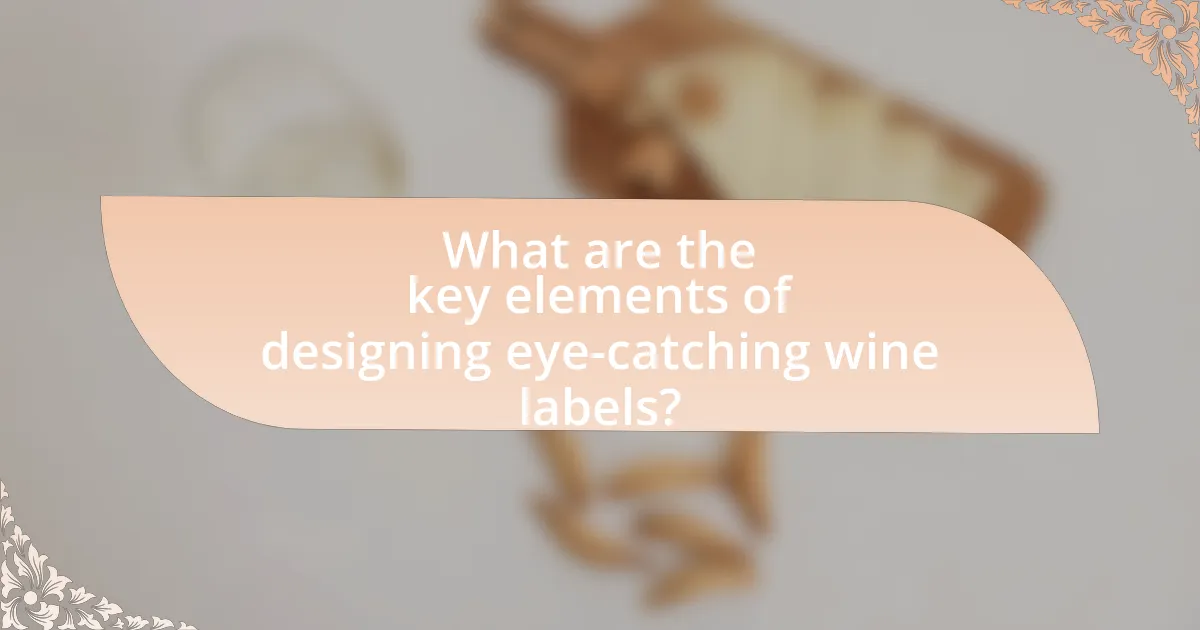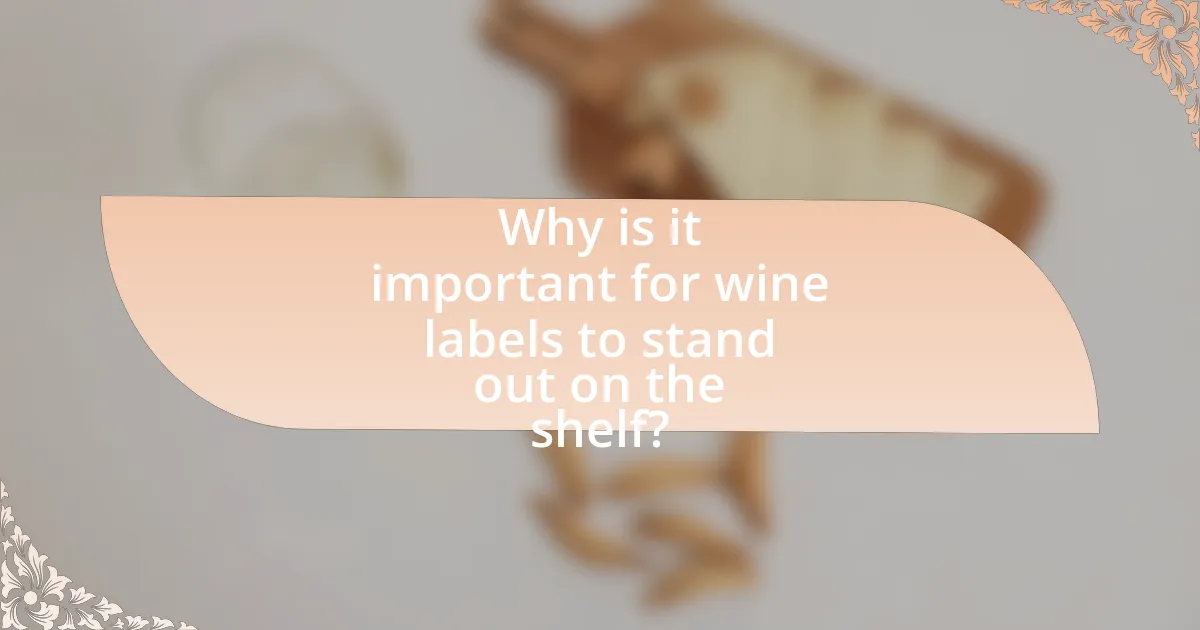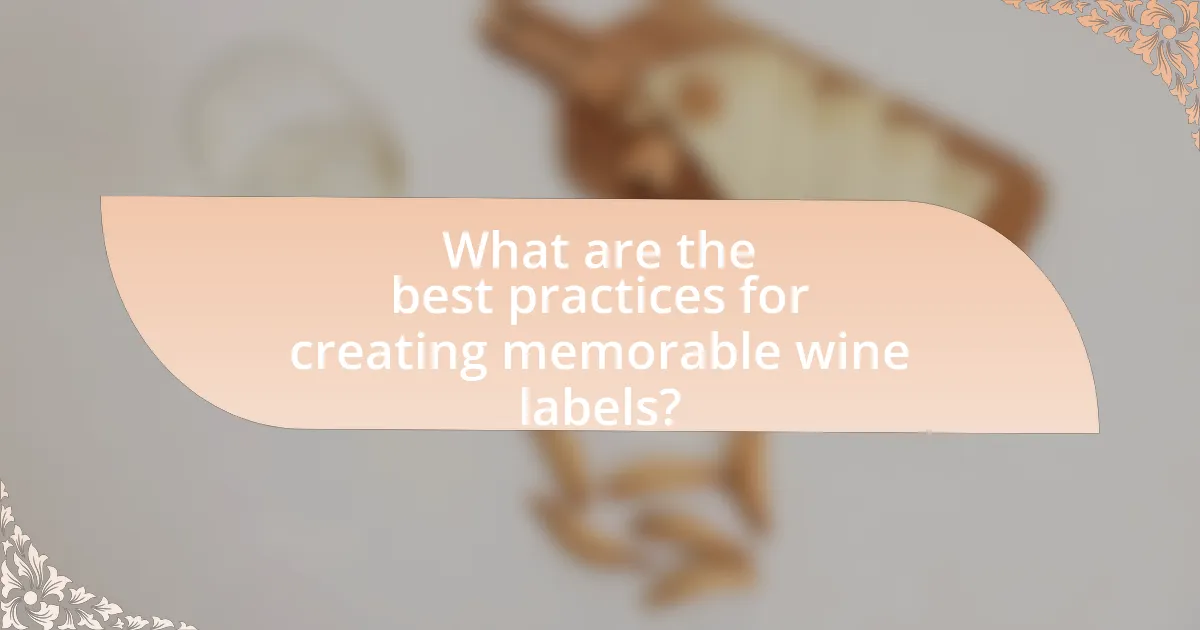The article focuses on the essential elements of designing eye-catching wine labels that effectively attract consumer attention and influence purchasing decisions. Key aspects discussed include the importance of unique typography, striking imagery, and cohesive color palettes, all of which contribute to a label’s visual appeal. The article also explores how color choice and typography impact consumer perception, the role of imagery in brand storytelling, and best practices for creating memorable labels. Additionally, it highlights current trends in wine label design, such as minimalism and sustainability, while addressing common mistakes to avoid and practical tips for effective label creation.

What are the key elements of designing eye-catching wine labels?
The key elements of designing eye-catching wine labels include unique typography, striking imagery, and a cohesive color palette. Unique typography captures attention and conveys the brand’s personality, while striking imagery, such as illustrations or photographs, can evoke emotions and tell a story about the wine. A cohesive color palette enhances visual appeal and helps the label stand out on shelves. Research indicates that consumers often make purchasing decisions based on label design, with studies showing that 67% of consumers consider packaging when making a purchase.
How does color choice impact the effectiveness of wine labels?
Color choice significantly impacts the effectiveness of wine labels by influencing consumer perception and purchase decisions. Research indicates that colors evoke specific emotions and associations; for instance, red often conveys richness and boldness, while white can suggest freshness and elegance. A study published in the Journal of Consumer Research found that consumers are more likely to choose products with colors that align with their expectations of the product category, demonstrating that appropriate color selection can enhance brand recognition and appeal. Additionally, contrasting colors can improve readability and visibility on shelves, further attracting potential buyers.
What psychological effects do different colors have on consumers?
Different colors evoke specific psychological effects on consumers, influencing their perceptions and purchasing decisions. For instance, red often stimulates excitement and urgency, making it effective for promotions, while blue conveys trust and reliability, appealing to consumers seeking quality. Green is associated with health and tranquility, attracting environmentally conscious buyers. Yellow can evoke feelings of happiness and optimism, but excessive use may lead to anxiety. Research by the Institute for Color Research indicates that color increases brand recognition by up to 80%, highlighting its significant impact on consumer behavior.
How can color combinations enhance label visibility?
Color combinations enhance label visibility by creating contrast and drawing attention to key elements. High contrast between text and background colors improves readability, making essential information easily discernible. For instance, using a dark font on a light background or vice versa can significantly increase legibility. Research indicates that color contrast can improve visibility by up to 80%, which is crucial in crowded retail environments where consumers make quick decisions. Additionally, complementary colors can evoke emotions and associations, further attracting potential buyers.
What role does typography play in wine label design?
Typography plays a crucial role in wine label design by influencing consumer perception and brand identity. The choice of font style, size, and arrangement can evoke specific emotions and convey the wine’s character, such as elegance or boldness. For instance, a serif font may suggest tradition and sophistication, while a sans-serif font can imply modernity and simplicity. Research indicates that 90% of consumer judgments about products are based on color and typography, highlighting the importance of these elements in attracting attention and communicating brand values effectively.
Which fonts are most effective for conveying brand identity?
Sans-serif fonts, such as Helvetica and Arial, are most effective for conveying brand identity due to their clean and modern appearance. These fonts enhance readability and create a sense of professionalism, which is crucial for brands aiming to establish trust and recognition. Research indicates that brands using sans-serif fonts are perceived as more contemporary and approachable, aligning with consumer preferences for clarity and simplicity. Additionally, serif fonts like Times New Roman can evoke tradition and reliability, making them suitable for brands that wish to convey heritage and sophistication. The choice of font directly influences consumer perception, as studies show that typography can affect brand recall and emotional response, reinforcing the importance of selecting the right font for effective brand identity communication.
How does font size influence readability and appeal?
Font size significantly influences both readability and appeal by directly affecting how easily text can be processed and how visually attractive it appears. Larger font sizes enhance readability by making text more legible from a distance, which is crucial for wine labels that need to attract consumers quickly in a retail environment. Research indicates that text sizes between 10 to 14 points are optimal for readability in print, while sizes above 14 points can improve visibility and attract attention, particularly for key information like the wine name or varietal. Additionally, a study published in the Journal of Vision found that larger fonts can evoke a more positive emotional response, thereby increasing the overall appeal of the label. Thus, appropriate font size not only aids in conveying information effectively but also enhances the aesthetic quality of wine labels, making them more appealing to potential buyers.
What imagery should be considered for wine labels?
Imagery for wine labels should include elements that reflect the wine’s origin, varietal, and brand identity. Common imagery includes vineyard landscapes, grape clusters, and regional symbols, which help convey the wine’s story and heritage. For instance, a label featuring a picturesque vineyard can evoke a sense of place and quality, while illustrations of grape varieties can inform consumers about the wine’s flavor profile. Additionally, artistic designs or historical references can enhance brand recognition and appeal to target demographics. Research indicates that visually appealing labels can significantly influence consumer purchasing decisions, with studies showing that 70% of consumers make their choice based on label design.
How can illustrations or photographs enhance brand storytelling?
Illustrations and photographs enhance brand storytelling by visually conveying a brand’s identity and values, creating an emotional connection with consumers. Visual elements can encapsulate the essence of a brand, making it more relatable and memorable. For instance, a study by the Nielsen Norman Group found that users remember 65% of information when paired with relevant images, compared to only 10% when presented with text alone. This demonstrates that effective imagery can significantly improve brand recall and engagement, ultimately influencing purchasing decisions.
What are the best practices for using images on labels?
The best practices for using images on labels include ensuring high resolution, relevance to the product, and clarity of design. High-resolution images prevent pixelation and maintain professionalism, which is crucial for consumer perception. Images should be relevant to the wine’s brand story or flavor profile, enhancing the label’s narrative and attracting the target audience. Clarity in design ensures that images do not overwhelm text, allowing for easy readability and effective communication of essential information. Research indicates that labels with clear, relevant imagery can increase consumer interest and purchase likelihood, as visual appeal significantly influences buying decisions in the wine market.

Why is it important for wine labels to stand out on the shelf?
Wine labels must stand out on the shelf to attract consumer attention and influence purchasing decisions. Research indicates that 60% of wine buyers make their selections based solely on label design, highlighting the critical role of visual appeal in a crowded market. Distinctive labels can convey brand identity, quality, and uniqueness, which are essential for differentiating products in a competitive landscape. Additionally, a well-designed label can evoke emotions and create a memorable experience, further enhancing consumer engagement and loyalty.
How does shelf visibility affect consumer purchasing decisions?
Shelf visibility significantly influences consumer purchasing decisions by enhancing product recognition and accessibility. When products are prominently displayed, they are more likely to catch the attention of shoppers, leading to increased likelihood of purchase. Research indicates that products placed at eye level or in well-lit areas experience higher sales, as consumers tend to gravitate towards items that are easily visible and accessible. For instance, a study published in the Journal of Retailing found that products with higher shelf visibility can increase sales by up to 30%. This demonstrates that effective shelf placement and visibility are critical factors in driving consumer behavior and purchasing choices.
What statistics support the importance of label design in sales?
Label design significantly impacts sales, with studies indicating that 67% of consumers make purchase decisions based solely on packaging. Research from the Packaging Association reveals that 72% of consumers believe that packaging design influences their buying behavior. Additionally, a survey by Nielsen found that 64% of consumers are more likely to buy a product if the packaging is attractive. These statistics underscore the critical role that effective label design plays in driving sales and influencing consumer choices.
How can unique designs differentiate a brand in a crowded market?
Unique designs can differentiate a brand in a crowded market by creating a distinct visual identity that captures consumer attention and fosters brand recognition. In the wine industry, for instance, research shows that 75% of consumers make purchase decisions based on label design alone, highlighting the importance of aesthetics in influencing buyer behavior. Unique designs not only convey the brand’s story and values but also evoke emotions, making the product memorable. This differentiation can lead to increased customer loyalty and higher sales, as consumers are more likely to choose a product that stands out visually among competitors.
What trends are currently influencing wine label design?
Current trends influencing wine label design include minimalism, bold typography, and sustainable materials. Minimalism emphasizes clean lines and simple graphics, allowing the wine’s quality to take center stage. Bold typography captures attention and conveys brand personality, often using unique fonts or sizes to stand out on shelves. Additionally, the use of sustainable materials reflects a growing consumer preference for environmentally friendly products, with many wineries opting for recycled paper and eco-friendly inks. These trends are supported by market research indicating that consumers increasingly value aesthetics and sustainability in their purchasing decisions.
How are minimalist designs impacting consumer perceptions?
Minimalist designs significantly enhance consumer perceptions by conveying clarity and sophistication. Research indicates that consumers often associate minimalist aesthetics with high quality and premium products, leading to increased brand trust and preference. For instance, a study published in the Journal of Consumer Research found that minimalist packaging can improve perceived product value, as consumers perceive less clutter as a sign of higher quality. This perception is particularly relevant in competitive markets, such as wine, where distinctiveness and elegance are crucial for attracting discerning customers.
What role does sustainability play in modern wine label design?
Sustainability plays a crucial role in modern wine label design by influencing consumer preferences and brand identity. Many wineries are adopting eco-friendly materials and practices to appeal to environmentally conscious consumers, as studies show that 66% of global consumers are willing to pay more for sustainable brands. This shift not only enhances the aesthetic appeal of the labels but also communicates a commitment to environmental stewardship, which can differentiate a brand in a competitive market. Additionally, sustainable label designs often incorporate recycled materials and eco-friendly inks, further reinforcing the winery’s dedication to sustainability.

What are the best practices for creating memorable wine labels?
The best practices for creating memorable wine labels include using distinctive design elements, clear typography, and storytelling. Distinctive design elements, such as unique shapes or textures, help a label stand out on the shelf, while clear typography ensures that the wine’s name and details are easily readable. Storytelling through imagery or text can create an emotional connection with consumers, making the wine more memorable. Research indicates that labels with strong visual appeal can increase consumer interest and purchase intent, highlighting the importance of these practices in the competitive wine market.
How can storytelling be integrated into wine label design?
Storytelling can be integrated into wine label design by using visual elements, typography, and narrative text that convey the wine’s origin, production process, or the winemaker’s philosophy. For instance, incorporating imagery that reflects the vineyard’s landscape or historical significance can create a connection with consumers, enhancing their emotional engagement with the product. Research indicates that labels with storytelling elements can increase consumer interest and perceived value, as they provide context and meaning behind the wine, making it more memorable.
What elements contribute to a compelling narrative on a label?
A compelling narrative on a label is primarily contributed by storytelling elements, visual design, and emotional connection. Storytelling elements include the origin of the wine, the winemaking process, and the vineyard’s history, which engage consumers by providing context and authenticity. Visual design encompasses typography, color schemes, and imagery that reflect the brand’s identity and attract attention on the shelf. Emotional connection is established through relatable themes or values, such as sustainability or family heritage, which resonate with consumers and enhance their purchasing decision. These elements work together to create a memorable and impactful label that stands out in a competitive market.
How can labels reflect the heritage or origin of the wine?
Wine labels can reflect the heritage or origin of the wine by incorporating specific geographical indicators, traditional symbols, and historical references. For instance, labels often feature the name of the wine region, such as Bordeaux or Napa Valley, which signifies the wine’s origin and the unique terroir associated with that area. Additionally, traditional imagery, such as local landmarks or cultural motifs, can evoke the history and customs of the region. Furthermore, regulatory terms like “Appellation d’Origine Contrôlée” (AOC) in France provide legal recognition of the wine’s origin, ensuring authenticity and quality linked to its heritage. These elements collectively communicate the wine’s story and provenance to consumers, enhancing its market appeal.
What common mistakes should be avoided in wine label design?
Common mistakes to avoid in wine label design include overcrowding the label with information, using illegible fonts, neglecting brand consistency, and failing to consider the target audience. Overcrowding can overwhelm consumers, making it difficult to identify key details such as the wine type and brand. Illegible fonts can deter potential buyers, as readability is crucial for effective communication. Neglecting brand consistency can confuse consumers and weaken brand identity, while not considering the target audience can result in designs that do not resonate with the intended market. These mistakes can significantly impact a wine’s marketability and consumer perception.
How can overcomplicating designs detract from brand messaging?
Overcomplicating designs can detract from brand messaging by obscuring the core message and confusing the audience. When a design is overly intricate, it can lead to visual clutter, making it difficult for consumers to quickly understand the brand’s identity and values. Research indicates that consumers often prefer simplicity in design, as it enhances recognition and recall; for instance, a study published in the Journal of Consumer Research found that simpler designs are more effective in conveying brand attributes. Therefore, a complex design can dilute brand messaging, leading to misinterpretation and reduced consumer engagement.
What are the pitfalls of neglecting target audience preferences?
Neglecting target audience preferences can lead to ineffective marketing and poor sales performance. When wine labels do not resonate with the intended consumers, they fail to attract attention, resulting in lower brand recognition and diminished customer loyalty. Research indicates that 70% of purchasing decisions are made at the point of sale, highlighting the importance of appealing to consumer preferences. Additionally, brands that overlook audience insights risk alienating potential customers, as they may perceive the product as irrelevant or unappealing. This disconnect can ultimately lead to wasted resources on marketing efforts that do not yield returns, emphasizing the critical need to align product design with audience expectations.
What practical tips can help in designing effective wine labels?
To design effective wine labels, prioritize clarity, visual appeal, and brand identity. Clear typography ensures that essential information, such as the wine’s name and varietal, is easily readable. Visual appeal can be enhanced through the use of color schemes and imagery that resonate with the target audience; for instance, vibrant colors may attract younger consumers, while muted tones may appeal to a more sophisticated demographic. Additionally, incorporating unique design elements that reflect the winery’s story or heritage can strengthen brand identity and create a memorable impression. Research indicates that consumers often make purchasing decisions based on label design, with studies showing that 67% of consumers consider packaging as an important factor in their buying choices.